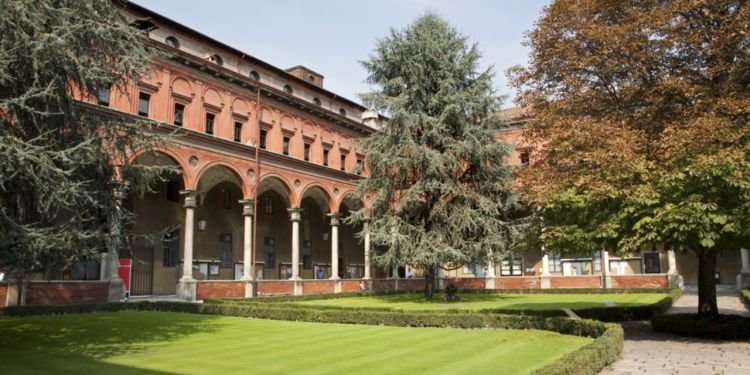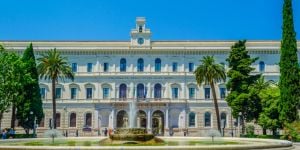
Milan is one of the best educational hubs in Italy and the whole of Europe. Indeed, the city has the largest number of universities and graduates in the country and sees a large number of international students spending an Erasmus period here. Milan may not be the capital of Italy, but it represents excellence in education in the economic and financial sector, fashion and fine arts. For this reason, it is one of the most popular destinations for international students in Italy and in Europe.
The traditional academic scene in Milan
The cultural panorama of Milan allows the universities to offer humanistic, technical-scientific, economic and artistic education. As the city with the largest number of international companies in Italy, it offers a wide range of employment and internship opportunities during and after studies. Moreover, Milan is a city of start-ups and start-ups need talent to contribute to research and innovation in all fields. Therefore, with ambition and a good university education, you will not go unnoticed!
For this reason, many Italians from the south of the country migrate to Milan to attend or complete their university studies, but also because certain specializations can only be done in Milan. This is also the case for young graduates who, once they have completed their internship, find a job and settle here permanently to begin their professional life.
Universities in Milan
Università degli Studi di Milano (Statale - UniMi): the Statale di Milano is a state university and the largest in the city. It is located near the city center, in the Ca'Granda building, but has other departments spread throughout the city. UniMi has 61,000 enrolled students (2021), 9 faculties, 58 departments, 48 institutes and a faculty of 2,500. It is a member of LERU (League of European Research Universities). The university offers mainly Italian language courses, with a limited possibility of courses in English. Annual fees vary between 3,000 and 6,000 euros, payable in two installments, together with ancillary fees: a first installment on the date indicated by the university to all students, and a second one, the date of which varies according to the economic status (ISEE, Indicatore della Situazione Economica Equivalente), merit, degree and professional status of each student.
Università di Milano-Bicocca: Bicocca is a public university established in Milan in 1997. It was founded in an industrial area in order to meet the requirements of urban regeneration in this part of the city. With over 35,000 students (2021), it is the second-largest public university in Milan and includes departments in economics, statistics, law, medicine, psychology, biotechnology, physics, computer science, mathematics and applications, environmental sciences, humanities, sociology and social research. The fees are similar to those of UniMi, with the first installment ranging from 300 to 500 euros, while the second installment can range from 600 to 4,200 euros minimum.
Politecnico di Milano (PoliMi): Founded in 1863 as the "Istituto Tecnico Superiore", it has become the best and largest technical university in Italy. Today it is divided into 16 departments and a network of nine schools: engineering, architecture and industrial design, spread over 7 campuses throughout the Lombardy region. Politecnico is home to about 47,000 students (2021), enrolled on all campuses in Milan and other neighboring Italian cities: Lecco, Cremona, Mantova and Piacenza. PoliMi offers courses in English and Italian. It pays particular attention to research, investing in numerous innovations and having several well-equipped laboratories. Annual fees and contributions range from a minimum of 890 euros to about 4,900 euros (the amount also depends on the number of university credits). Students pay in two installments: a fixed amount of EUR 888.59 and a second installment at a date customized to each student's profile.
Università Bocconi: Bocconi is a private university founded in 1902 and the first in Italy to introduce economics and business courses. Today, according to the Wall Street Journal and Forbes, it is one of the top 20 business schools in the world with eight departments: accounting, social and political sciences, economics, finance, management and technology, marketing, decision sciences and legal studies. Courses are taught in Italian, but there is also an emphasis on English language courses and programs. Since 1971, the campus has offered a business school, the SDA Bocconi School of Management. Bocconi is one of the most expensive universities in Italy, with fees reaching 15,000 euros per year. The university offers grants and scholarships (ISU Bocconi) that cover part of the university fees. These scholarships are awarded on the basis of merit and specific criteria: grades, age, entrance test results, economic situation and work experience. In particular, it is possible to obtain scholarships from certain partner companies.
Università Cattolica del Sacro Cuore (UniCatt): The Catholic University of the Sacred Heart is one of the main private universities in Milan, located next to the Sant'Ambrogio Church. Founded in 1921, UniCatt is considered the largest Catholic university in the world, with 42,000 students enrolled. It specializes in the humanities, economics, social sciences and natural sciences (with its collaborative institute - Istituto Toniolo, which places great emphasis on research). The university has branches in Rome, Brescia, Piacenza and Cremona and also offers courses in agriculture and medicine. The Università Cattolica offers strong international programs and many one-year Master's degrees in English. The main office is located at Largo Agostino Gemelli, where students can obtain information about living in Milan and about the study programs. The cost of studying at UniCatt varies between 3,000 and 10,000 euros per year, depending on the specialization. Payment is made in two or three installments, with a lump sum of 1200 euros for the first installment. It is possible to obtain partial scholarships from the Università Cattolica and to do a part-time paid internship for the university. Grants vary according to the program and the nationality of the students. For information on available grants, see the Educatt website.
IULM (Free University of Languages and Communication): IULM is a private university specializing in business communication, interpreting and translation, tourism, fashion and cultural heritage. Founded in 1963, it has two locations, the main one in Milan (near the Romolo metro station) and the second one in Rome. The university has about 8,000 students and three faculties: Art Tourism, Communication, and Interpretation/Translation. The university encourages foreigners to join its student population through many courses in English. Studying at IULM costs between 3,700 and 10,000 euros per year. It offers the possibility of working for its offices for a maximum of 180 hours per academic year.
Università Vita-Salute San Raffaele: founded in 1996, the University is not divided into departments but into three faculties: medicine, philosophy, and psychology. It is characterized by an integration of teaching and research in the categories of basic research, philosophical research and social research. Located in the northeastern part of the city, the University is affiliated with the San Raffaele Hospital of Milan, its main seat. Its mission is to be able to answer the question "Quid est homo" (What is man?), from a biological, psychological, and even spiritual point of view. UniSR is considered the second-best private university in the country and offers courses in English to international students. Fees vary according to the program, ranging from about 4,600 to 20,000 euros, depending on the type of specialization. It is possible to apply for a partial scholarship directly from the university.
Art schools in Milan
Accademia di Belle Arti di Brera: The Academy of Fine Arts was founded in 1776 and specializes in art and music education, creative arts and historical and cultural disciplines. It is divided into three departments: visual arts, design and applied arts, and communication and art education. Its heritage, its gallery in the Pinacoteca di Brera (which houses masterpieces by, for example, Boccioni, Caravaggio and Hayez), and its architectural setting contribute to its appeal to aspiring artists. Its openness to globalization makes it particularly attractive to foreign students. It is the institution with the largest number of students from abroad, with over 850 foreigners from 49 countries. The academy offers undergraduate and graduate degrees, but places are limited and access is by entrance examination. Being a public institution, the fees to be paid are regional and national taxes of around €300 and annual fees of up to €3,200.
Nuova Accademia di Belle Arti (NABA): the new Academy of fine arts is private and located in the Navigli district. It has two departments: Visual Arts and Curatorial Studies - Design and Applied Arts. NABA has laboratories for computer graphics, video editing, sound design, adaptation, modeling and painting, and a workshop for working with materials such as plastic, iron and wood. It offers bachelor's and master's degree courses. With 3,000 students, it is particularly open to international exchange students. Studying at NABA costs between €9,600 and €18,600 per year for EU citizens and €18,600 for non-EU nationals. The academy offers scholarships based on students' projects and financial means, as well as financial aid and discounts for master's students who have obtained a bachelor's degree at the university.
University admission in Milan
Each university has its own registration rules, so you should consult the website of the institution you are interested in or contact their international services. In addition, there are different registration rules for non-EU students, Italians and EU students.
EU students do not need a visa to study in Italy; however, diplomas obtained abroad must be legalized according to Italian law. Each document must be accompanied by an official translation into Italian and presented to an Italian diplomatic-consular representation. The Italian embassy or consulate will provide a declaration of value (Dichiarazione di valore), confirming that the grades are equivalent to the Italian education system. Once in Italy, students must enroll directly at the university.
Non-EU students must apply for a visa for Italy (online or in person, or by pre-registration) in advance, especially as the procedures are lengthy. Once the application has been accepted, non-EU citizens residing abroad must submit a visa application to the Italian diplomatic representation (embassy, consulate) in the country of origin (where the Dichiarazione di valore must be made).
All documentation must be translated by a state-approved translator and notarized.
Once the visa for Italy is in hand, students must go personally to the university to register (Immatricolazione) and then apply for the long-term residence permit (Permesso di soggiorno a motivo di studio) within eight days of their arrival in Italy. This permit is renewable every year and can be renewed for another year after graduation in the context of finding a job in Italy. It is advisable to register at the University, to ask for the tax code and to register with the health service (Servizio Sanitario Nazionale) before applying for the residence permit, as all these documents will help to speed up the procedure.
Financing your studies in Milan
Italian universities set fees according to students' family income (ISEE). However, these rules apply mainly to Italian citizens. All universities have special offers for students with special needs.
Students enrolled at public universities have the possibility to apply for a DSU (Diritto allo studio) grant financed by the Lombardy Region at the Grants Office.
These grants (borse di studio) allow free access to university canteens, provide a 5 euro voucher (or the equivalent of a meal ticket) per day for commuter students to spend in some supermarkets and cover part of the student's expenses.
To qualify for a student grant in Milan, the conditions are as follows:
- present a declaration of low/medium family income;
- have accumulated a minimum number of credits for the year (from 20 to 35, depending on whether it is a baccalaureate or master's degree)
- not be receiving other scholarships in the same year,
- be registered for full-time studies,
- not be enrolled in the same course for more than one year.
In addition, all universities offer part-time paid employment opportunities in some academic departments.
It is not easy to move abroad as part of your studies, but Milan represents a good opportunity to get your career off to a flying start once you graduate. The city offers solid ground for learning and career building.
Useful link:
We do our best to provide accurate and up to date information. However, if you have noticed any inaccuracies in this article, please let us know in the comments section below.












Comments